Are you a Quiet Speculation member?
If not, now is a perfect time to join up! Our powerful tools, breaking-news analysis, and exclusive Discord channel will make sure you stay up to date and ahead of the curve.
This week I start my article with an apology. I had stated that I would be altering a Rattleclaw Mystic and creating a guide for you. Work and an ever changing life situation have caused me to alter this week's article instead of altering a Magic card. If you were very excited about the Rattleclaw Mystic, I apologize. It will be coming next week.
This week’s article will be a break from the practical applications of painting. Those of you who have been members on this site for more than five years (thank you) will remember that I once wrote a similar article series for this site. One of those classic articles was about color theory. I'd like to reprise it here.
I will discuss some of the color theory that goes into matching colors and ultimately creating better alters. It would be easy to blow this article off as filler, but any kind of artist needs to know the theory of color. Understanding the theory behind what we see is the biggest step towards eliminating the need for a guide to paint cards. Those of you who have been having trouble matching color will want to study this article closely.
The Color Wheel
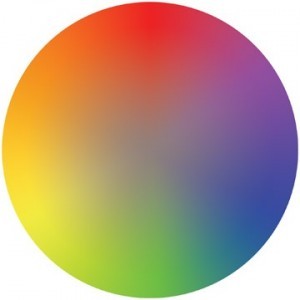
To understand anything about color, we must familiarize ourselves with the color wheel. We all remember this from high school art class, but it is easy to lose touch with just how fundamentally important this tool is.
The three primary colors or hues (Red, Blue, Yellow) and the three secondary hues (Purple, Green, Orange) make up its basis. All of the other colors exist as a mixture of any of these six colors. Adding white or black to any color will change its value, thus creating a different version of that color.
On the more practical side, we can use the color wheel to help us find exactly which colors we need to mix to achieve a certain hue or value. Additionally, this tool is free from the effects of light and shadow within a composition and therefore gives us a more accurate reading of color than just looking at the picture we are trying to match.
It’s All an Illusion…
Color is a very tricky subject. There are illusions that are created by light, shadow, and even adjacent colors.
Take a look at the checkerboard image below. Our brains will apply logic to this picture and tell us that “A” cannot possibly be the same color as “B” because one is a black square and one is a white square. The reality of the situation is that both squares are the exact same color.
Square “B” looks lighter than “A” because of the light and shadow of the squares around it. This is an example of the Color Constancy Illusion, and people far more learned than myself study it.
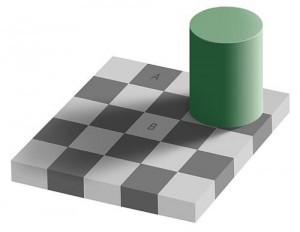
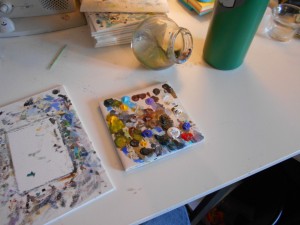
The color of the light you are using will also affect how you perceive the color. You can see examples of this anywhere there is shadow.
Take a look at the surface of my desk, and note the colors. This desk is white. It has a standard incandescent desk lamp that is giving off yellow light. The part of the desk that is illuminated by the yellow light is turned yellow. It is also partially lit by an open window. The natural light is giving parts of this desk a blue tone.
If we are to re-create this image accurately we must use blue and yellow tones to do so. Painting a white desk using only white will not get the job done.
Furthermore, as shown in these color cubes, we see that it is not only light that can change our perception of color, but the hues and values around that color as well. Notice that a dominance of one complimentary color can mute the appearance of the other.
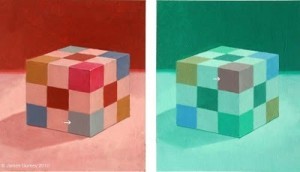
When images become more complex, our brain still strives to maintain its opinion of the color we see, and illusions like the ones shown here are the result. Once we have grasped this concept, we understand that logic plays almost no role in color theory.
Putting It All Together
Now that we have a basic understanding of the theory, we can observe it in action.
Look at the picture of the Aether Vial that I altered. The trees that grow behind the woman appear brown, but as I painted it, I realized that I needed a value so light, that it was almost tan on my palette. It appears brown due to its proximity to the very light background and the deep shadows portrayed on the tree.
Similarly, the green highlights on the tree are actually a dark shade of green that appear light due to the apparent darkness of the wood. The green on the trees is the same as on the woman's shoulder pad. This card shows a dark color made to appear light by a light color made to appear dark. Does your brain hurt yet? Mine does.
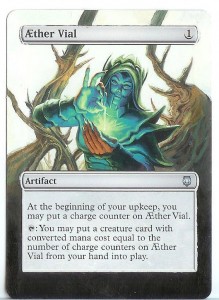
"If he sees a thing, he must say that he sees it, whether it was what he thought he was going to see or not. See first, think later, then test. Otherwise you will only see what you were expecting." (Life, the Universe, and Everything, by Douglass Adams)
Allowing yourself to believe that these examples are possible is the first step to being able to create these illusions yourself. Utilizing this information in practice will help you train your eye to recognize exact colors sooner. This will help you save yourself a lot of paint and frustration, but most importantly time, as you continue with your painting.
A Giveaway!
Before I leave you to your painting I'd like to announce that when I do complete the Rattleclaw Mystic I will be giving it away to one lucky Twitter follower. All you have to do for a chance to win is follow me @PaintersServant. Additional chances to win will be given to those who tweet some of their own altered cards to me.
Those who already follow me may remember that I give away an alter every time a set is released. This one will be a little late, but nevertheless a free card will be had by one of my followers! Good Luck!




